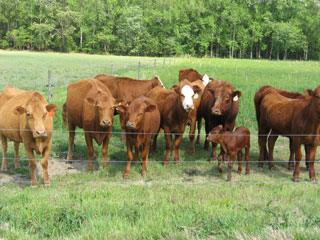
Here's a picture of Patrick Robinette's Senepol cows in a North Carolina meadow, pausing from a round of grass chewing. The baby up front was born
two nights earlier. The one on the left, now 17 years old, has had 16 calves. I
have never encountered such curious cows. When I went into the field with them,
they took turns approaching me and sniffing at me, tentatively, the way an
inquisitive cat might sniff at a stranger. After tinkering with all kinds of
cattle breeds, Patrick is partial to the Senepol. With origins on the island of St. Croix, Senepol cattle can tolerate the hot, humid North Carolina summers.
"Your Black Angus will spend the whole summer day standing in the shade of
a tree," says Patrick. The Black Angus is also bred to eat corn, which is
something Patrick never feeds his cattle, not even in the last months. From
cradle to grave, Patrick's cattle indulge their one great pleasure: munching
fescue, rye, clover, orchard grass, and millet. But Patrick has more than just
humane reasons for preferring Senepol cattle in his southern meadows. "I
want my cattle to fatten up on all that lush grass," he says. "When
they're standing in the shade just to survive, they're not eating anything. And
happy, unstressed cattle also produce more tender, flavorful meat." It's
not just the humane method of raising cattle that keeps demand for Patrick's
product way out ahead of the supply. Nor is it the heart-healthy Omega 3s and
conjugated linoleic acids (CLAs). The flavor is out of this world. Real beef
flavor, not too gamey. Eating a hamburger from his ground chuck, I had this
Proustian flashback to seventies barbecues, when I was twelve years old.
"Exactly," said Patrick. "Before the grain embargo in 1980. All
that corn with no place to go." "What do you know about the grain
embargo?" I asked Patrick, who would have been three years old when Jimmy
Carter made that fateful decision. Patrick is only thirty years old now,
idealistic, and so vertically integrated that when I called him early this morning
he was on his way to the slaughterhouse to personally oversee the cutting of
the New York Strips and flank steaks that would be served the following evening
at
Zely & Ritz in
Raleigh, North Carolina, where
Slow Food founder
Carlo Petrini ate after speaking at
North Carolina State's McKimmon Center. Like Patrick's beef,
chef Sarig Agasi's menu at Zely & Ritz is a Slow Food showpiece. And
reasonably priced, too. For more on Patrick's beef, check out his web site at
here.


